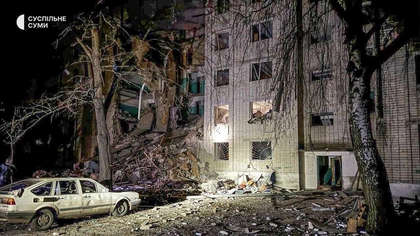Ukrainian strikes already reach deep into Russian territory. Domestically made unmanned aerial vehicles (UAVs) have carried out dozens of successful missions, hitting Russian oil refineries and dumps, and thus inflicting serious damage to Russia’s economy. Gas and diesel price hikes have further add to Russia’s huge losses from the forced suspension of exports. According to Ukrainska Pravda, in 80 percent of attacks, Ukraine has used its long-range kamikaze drone “Liutiy”.
About the Liutiy
JOIN US ON TELEGRAM
Follow our coverage of the war on the @Kyivpost_official.
The Liutiy (meaning “fierce”) is a Ukrainian long-range strike UAV capable of hitting targets at distances up to 1,000 km. Its high efficiency has been proven by a series of successful attacks on Russian oil refineries, fuel depots, helicopter bases and other strategic facilities in Sochi, Adler, St. Petersburg, Novolipetsk, Ryazan, Nizhniy Novgorod and Tatarstan.
In terms of design and appearance, the Liutiy resembles the Turkish Bayraktar-TB2, having a similar fuselage and tail assembly which ensure excellent aerodynamic performance and low fuel consumption.
Constructed of light materials, mostly fiberglass, the Liutiy can carry a 50-kg warhead. Its weight can be increased to 75 kg, though its range in that case would be reduced to 750-800 km. The Liutiy is also convenient to transport, being composed of separate modules which can be easily reassembled.

Russian Drone Strike on Sumy Dormitory Kills Ten, Including a Child, and Injures 13
Like most Ukrainian long-range UAVs, the Liutiy is distinguished for autonomy and precision, thanks to its hybrid guidance system.
The inertial system ensures full autonomy on the flightpath while satellite communication makes it possible for the operator to change the trajectory at any moment for maximum precision. Satellite communication is not always available due to interference or jamming by Russian electronic warfare (EW) systems, but, when the opportunity presents itself, the operator can take control to complete the mission with maximum results.
Of course, all systems have their flaws. The initial versions of the Liutiy were vulnerable to Russian EW, however, subsequent iterations appear to have better protection against jamming and possibly alternative channels for communication and targeting, as evident from the latest successful strikes on Russian oil refineries.
Development, refinement and successes
Ukraine’s dire need for new weapons to fight the Russian invaders, combined with limited resources, prompted bold solutions. Ukraine had no long-range missiles to reach targets deep inside Russian territory, so UAVs were an obvious solution. In fact, they do the same job as cruise missiles, albeit slower, and they are a lot less expensive.
The first prototype of the Liutiy was developed by enthusiasts who invested their own money into the project. In the initial stages of the long-range drone program, the Ukrainian military were rather skeptical about its prospects as it was hard to imagine such a conspicuous aircraft with a wingspan of 6.7 meters crossing into Russia’s airspace through air defenses and hitting its target. The high probability of being spotted by Russian radars, being misguided or disabled by EW, or destroyed by air defenses on the approach, appeared to make the mission impossible.
The project gained impetus from the experience of the Iranian kamikaze drones which Russia began to use widely against Ukraine. In terms of role and functional capabilities, the Liutiy bears close resemblance to the Shahed: both drones can be considered a relatively inexpensive means of destroying or damaging high-value targets in the enemy’s deep rear. For this reason, Ukraine opted for this method against critical facilities far across the border. It is also efficient: even if just one of a dozen Liutiy drones (each worth about $200,000) hit their target, the estimated damage to the enemy side would likely be far greater.
The Liutiy was first test-flown in April 2023, when it was launched from Odesa and aimed at Zmiiny, the then occupied island in the northwestern part of the Black Sea. Mid-flight, the drone malfunctioned and lost connection with the operator, so automatically made a U-turn back to the launch site. It is hard to imagine what could have happened if the drone with 50 kilos of explosive had fallen onto a city of one million people. Since the project was kept secret at all stages, including testing, the military command did not give the air raid alarm in the city. Fortunately, when the drone was just 30 km from the city, the operators managed to restore connection and avert an imminent disastrous accident.
That was followed by several other failed attacks: in one case the drone did reach its target and even hit it, but the warhead did not explode. Russians published photos of an unexploded Liutiy warhead. It was clearly necessary to modernize the system.
Fortunately, despite the initial failed attempts the Liutiy gained trust with the Ukrainian command. A real boom of orders followed after the spectacular strike at a major oil refinery in St. Petersburg. It proved able to reach and destroy enemy targets far across the border. Since then, Liutiy drones in sufficient numbers have been supplied to, and used by, Ukraine’s Security Service, the Military Intelligence and even the Air Force.
Liutiy drones most commonly attack in swarms: several drones approach and hit the target one by one. This tactic raises the chances for success and also testifies to the fact that the domestic production of UAVs is gaining momentum. So, such attacks may well become even more massive and frequent.
You can also highlight the text and press Ctrl + Enter






![[VIDEO] Russian Kalibr Missiles Pierce Through the Sky Over Odesa as Dawn Breaks](https://static.kyivpost.com/storage/2024/11/17/71e84b1f9a017619f72fb7ba94a9845a.png?w=420&q=75&f=webp)
